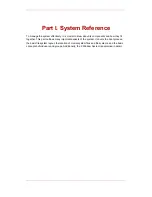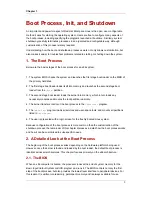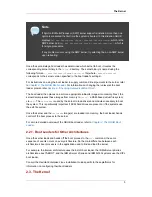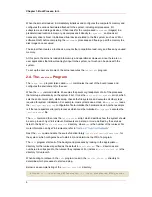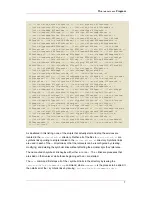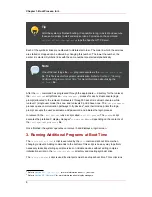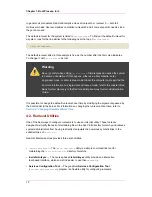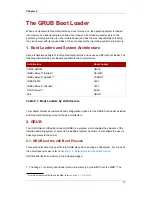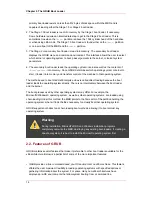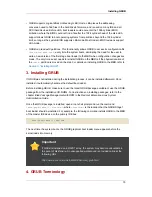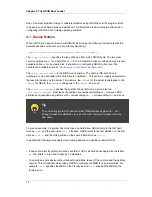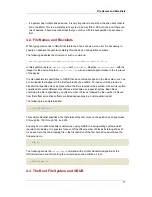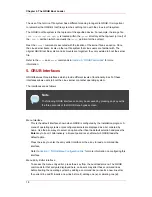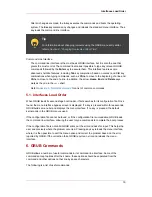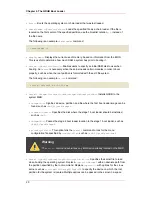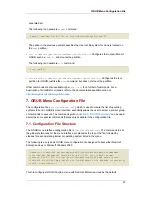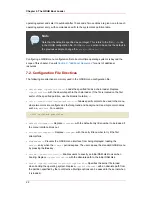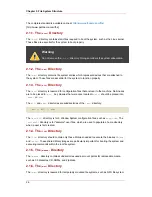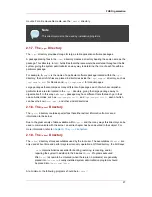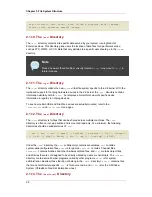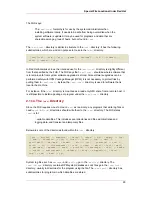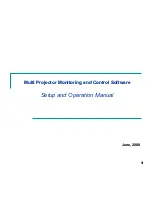
primary boot loader exists on less than 512 bytes of disk space within the MBR and is
capable of loading either the Stage 1.5 or Stage 2 boot loader.
2. The Stage 1.5 boot loader is read into memory by the Stage 1 boot loader, if necessary.
Some hardware requires an intermediate step to get to the Stage 2 boot loader. This is
sometimes true when the
/boot/
partition is above the 1024 cylinder head of the hard drive
or when using LBA mode. The Stage 1.5 boot loader is found either on the
/boot/
partition
or on a small part of the MBR and the
/boot/
partition.
3. The Stage 2 or secondary boot loader is read into memory. The secondary boot loader
displays the GRUB menu and command environment. This interface allows the user to select
which kernel or operating system to boot, pass arguments to the kernel, or look at system
parameters.
4. The secondary boot loader reads the operating system or kernel as well as the contents of
/boot/sysroot/
into memory. Once GRUB determines which operating system or kernel to
start, it loads it into memory and transfers control of the machine to that operating system.
The method used to boot Red Hat Enterprise Linux is called direct loading because the boot
loader loads the operating system directly. There is no intermediary between the boot loader
and the kernel.
The boot process used by other operating systems may differ. For example, the
Microsoft
®
Windows
®
operating system, as well as other operating systems, are loaded using
chain loading. Under this method, the MBR points to the first sector of the partition holding the
operating system, where it finds the files necessary to actually boot that operating system.
GRUB supports both direct and chain loading boot methods, allowing it to boot almost any
operating system.
Warning
During installation, Microsoft's DOS and Windows installation programs
completely overwrite the MBR, destroying any existing boot loaders. If creating a
dual-boot system, it is best to install the Microsoft operating system first.
2.2. Features of GRUB
GRUB contains several features that make it preferable to other boot loaders available for the
x86 architecture. Below is a partial list of some of the more important features:
• GRUB provides a true command-based, pre-OS environment on x86 machines. This feature
affords the user maximum flexibility in loading operating systems with specified options or
gathering information about the system. For years, many non-x86 architectures have
employed pre-OS environments that allow system booting from a command line.
Chapter 2. The GRUB Boot Loader
14
Summary of Contents for ENTERPRISE LINUX 4.5.0 -
Page 1: ...Red Hat Enterprise Linux 4 5 0 4 5 0 Reference Guide ISBN N A Publication date ...
Page 2: ...Red Hat Enterprise Linux 4 5 0 ...
Page 4: ...Red Hat Enterprise Linux 4 5 0 ...
Page 24: ...xxiv ...
Page 26: ......
Page 36: ...12 ...
Page 72: ...48 ...
Page 112: ...88 ...
Page 122: ...98 ...
Page 140: ...116 ...
Page 142: ......
Page 300: ...276 ...
Page 318: ...294 ...
Page 320: ......
Page 332: ...308 ...
Page 350: ...326 ...
Page 378: ...354 ...
Page 388: ...364 ...
Page 394: ...370 ...
Page 395: ...Part IV Appendixes ...
Page 396: ......


